Trees Birds Mammals Fish Amphibians Reptiles
Wild Algarve
Bookshop
Oudemansiella mucida (Schrad.) Höhn. - Porcelain Fungus
Phylum: Basidiomycota - Class: Agaricomycetes - Order: Agaricales - Family: Physalacriaceae
Distribution - Taxonomic History - Etymology - Identification - Culinary Notes - Reference Sources
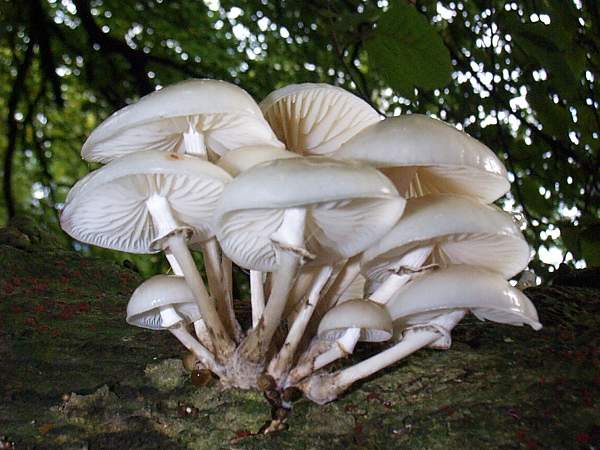
Oudemansiella mucida (increasingly being referred to by the synonym Mucidula mucida), the Porcelain Fungus, is
specific to beech wood. It appears in autumn on dead trunks and on
fallen branches, and occasionally it also grows on dead branches high up in living trees.
This beautiful fungus is featured on the front cover of the new edition of .
Distribution
Common and widespread in Britain and Ireland, Oudemansiella mucida occurs throughout northern Europe, but in southern Europe where Beech is not found the Porcelain Fungus is also absent.
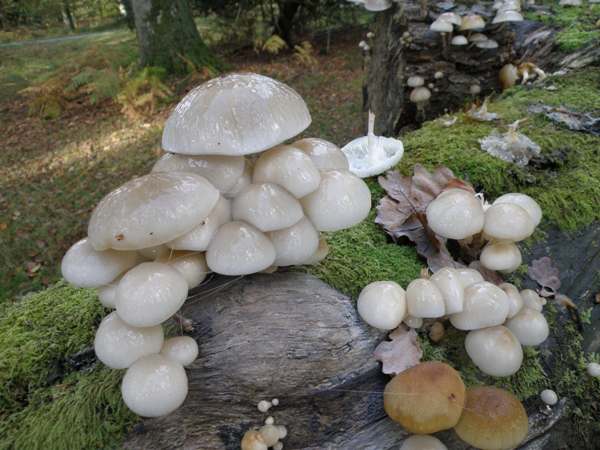
I have seen fallen Beech trees literally covered in Porcelain Fungus (also referred to as Porcelain Muchroom or as Beech Tuft), and few other fungi seem to get much of a nibble. This, it has been discovered, is because Oudemansiella mucida releases a powerful fungicide that deters or even anihilates competitors.
Known as a strobilurins, these kinds of anti-fungal agents are used increasingly to protect crops from attacks by powdery mildews and other microfungi. Although subsequently improved upon by industrial chemists, the first strobilurin fungicides were isolated from wood-rotting mushroom fungi such as Oudemansiella mucida and, in particular, another white-spored wood-rotting species that goes by the name of Strobilurus tenacellus (commonly known as the Pinecone Cap), from which these kinds of agents get their common name 'strobilurins'.
When these mushrooms grow underneath a large branch or a fallen trunk, the stems curl so that the caps are all held horizontal and with their gills facing downwards - as seen here.
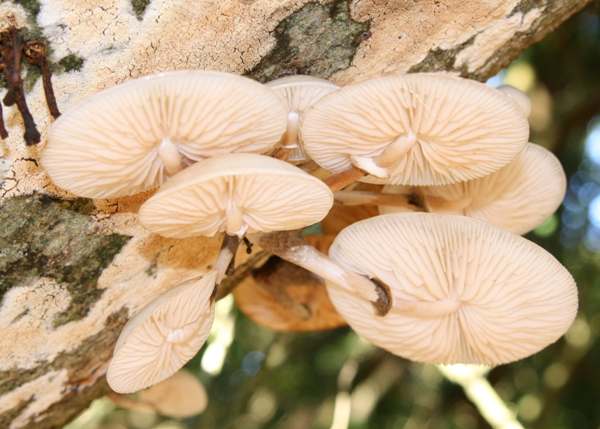
Taxonomic history
In 1794 the German botanist and mycologist Heinrich Adolf Schrader (1767-1836) described the Porcelain Fungus and gave it the scientific name Agaricus mucidus. (Most of the gilled mushrooms were included initially in the genus Agaricus!) Its present accepted name dates from 1909, when Austrian mycologist Franz Xaver Rudolf von Höhnel (1852 - 1920) transferred this species to the genus Oudemansiella.
Synonyms of Oudemansiella mucida include Agaricus mucidus Schrad., Collybia mucida (Schrad. : Fr.) Quél., Armillaria mucida (Schrad.) P. Kumm., and Mucidula mucida (Schrad.) Pat.
Etymology
The genus Oudemansiella was established in 1881 by Italian-Argentinian mycologist Carlos Luigi Spegazzini (1858 - 1926) and named in honour of the Dutch mycologist Cornelius Anton Jan Abraham Oudemans (1825 - 1906).
The specific epithet mucida refers to the layer of transparent mucus that covers the caps of these mushrooms.
Identification guide
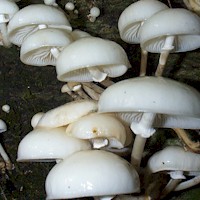 |
The Porcelain Mushroom, Oudemansiella mucida, is also sometimes referred to by the common name of Poached Egg fungus - a reference to the white of the
egg rather than the yolk, of course!
This fungus is saprobic or weakly parasitic upon beech trees, and on breezy days in
autumn it is not unusual to see what appear to be tiny parachutes falling
from high branches after the fungi have been dislodged by the wind. |
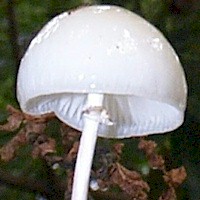
|
Cap
2 to 8cm in diameter, semi-transparent and
white, the caps of this lovely mushroom are rounded and tend to remain
broadly domed rather than completely flat as the fruiting bodies mature.
The gills show through the thin cap flesh, giving the margin a striate
appearance.
A mucous slime covers the cap during wet weather. |
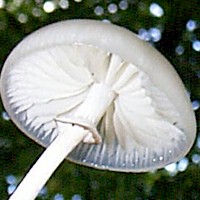 |
Gills
Adnate, broad and very distant, the gills of the Porcelain Mushroom are
translucent white at first, sometimes developing an ochre tint as the
fruiting body ages. |
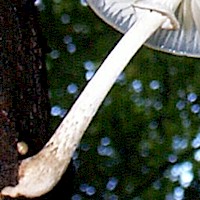 |
Stem
Slender, with a substantial stem ring, the stems are 3 to 7mm in diameter,
up to 8cm long, and often curved so as to bring the cap to the horizontal
in situations where large tufts of Porcelain Mushrooms are attached to a
small area of the host.
Above the ring, the stem is white; below the ring it is slightly striate
and greyish. |
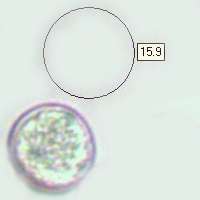 |
Spores
Globose to subglobose, smooth, very thick-walled, 14-18 x 11-16 μm.
Spore print
White. |
Odour/taste |
Not distinctive. |
Habitat & Ecological role |
Saprobic on stumps, trunks and branches of dead beech
trees; also weakly parasitic upon living beech trees, often very high up. |
Season |
July to October in Britain and Ireland. |
Similar species |
There are many other white mushrooms, but none with such translucency and
greasy caps that are so specifically associated with beech trees. |
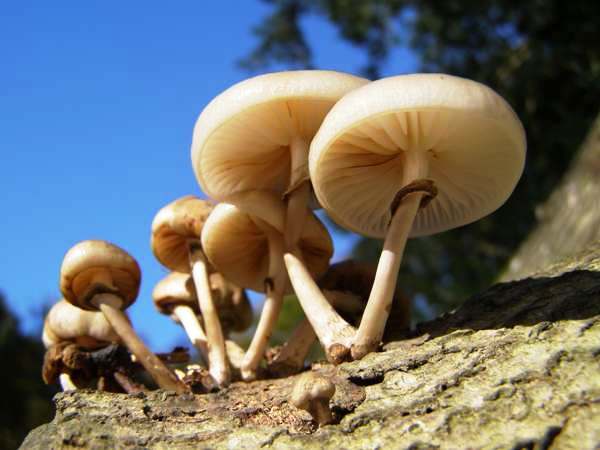
Culinary Notes
Provided that the skin is thoroughly washed (or peeled from the caps) to remove the mucus,
these mushrooms are edible, although their slimy covering is probably enough to put most people off. Only larger caps are worth collecting,
because the flesh is thin and insubstantial.
Above: Sunlight shining through the translucent caps of Porceain Mushrooms on a fallen beech trunk - Aviemore, Scotland.
Reference Sources
Fascinated by Fungi, 2nd Edition, Pat O'Reilly 2016, reprinted by Coch-y-bonddu Books in 2022.
Dictionary of the Fungi; Paul M. Kirk, Paul F. Cannon, David W. Minter and J. A. Stalpers; CABI, 2008
Taxonomic history and synonym information on these pages is drawn from many sources but in particular from the British Mycological Society's GB Checklist of Fungi.
Top of page...
Fascinated by Fungi. Back by popular demand, Pat O'Reilly's best-selling 450-page hardback book is available now. The latest second edition was republished with a sparkling new cover design in September 2022 by Coch-y-Bonddu Books. Full details and copies are available from the publisher's online bookshop...